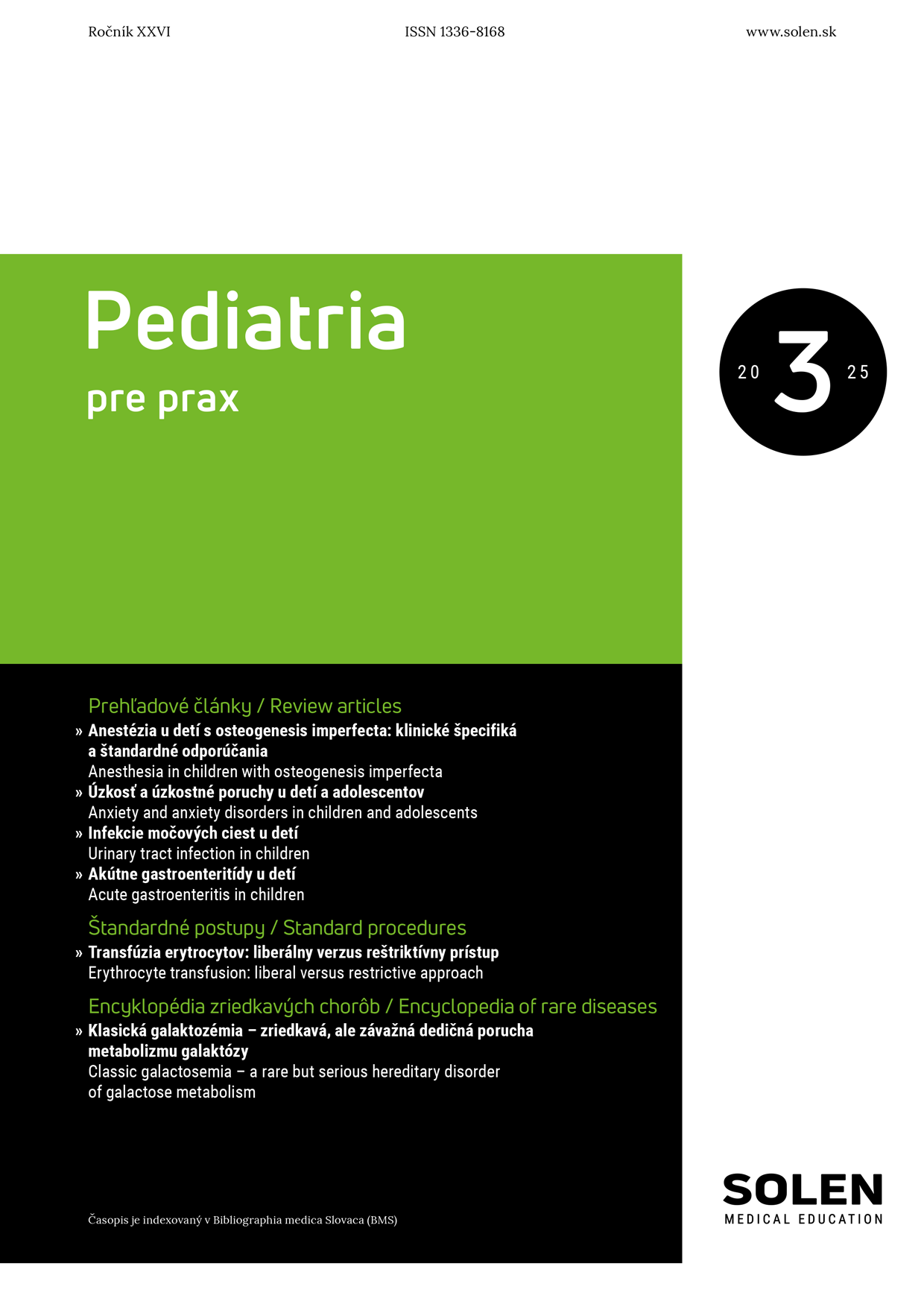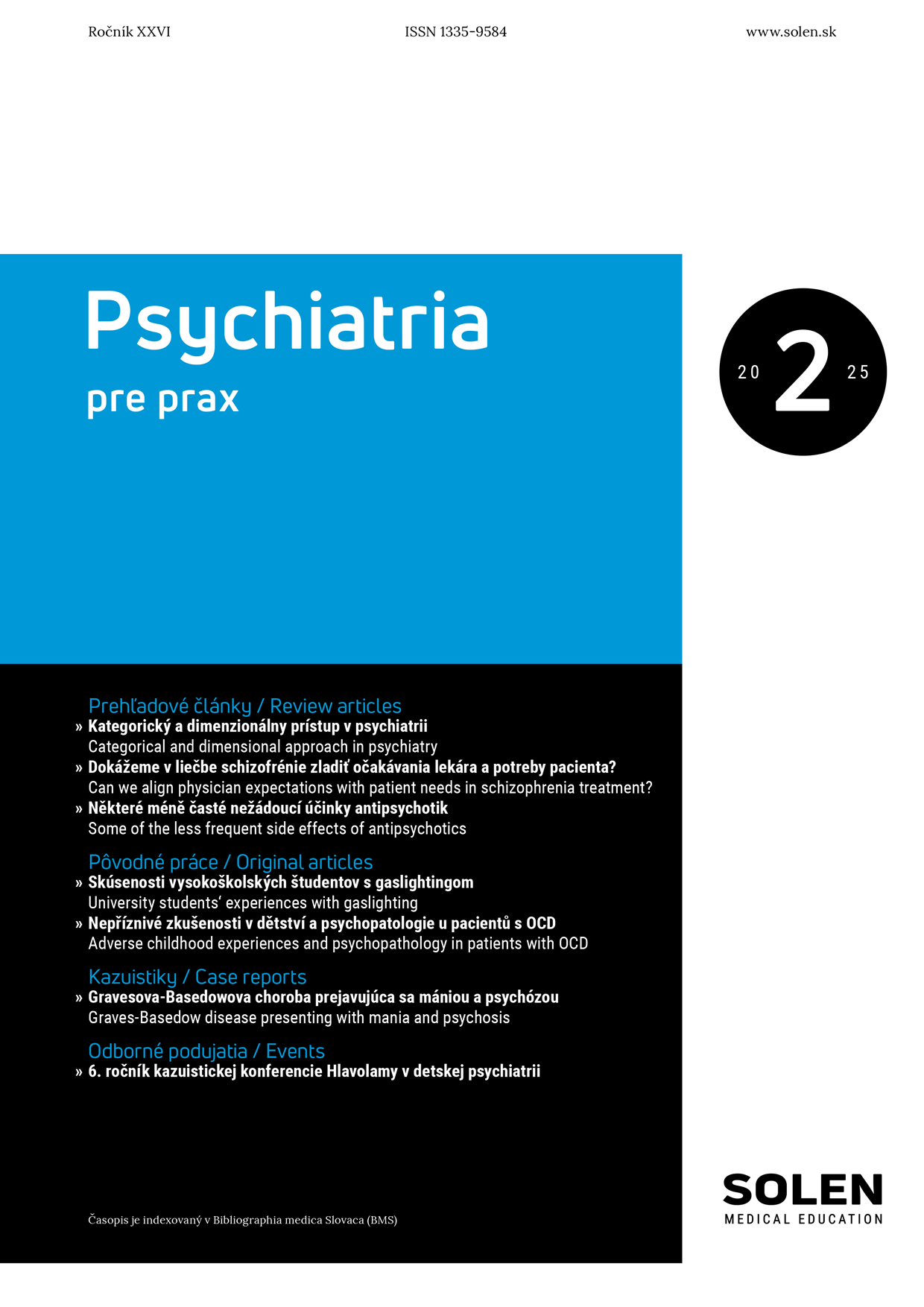Neurológia pre prax 6/2014
Myasténia gravis a žena: tehotenstvo, pôrod, puerpérium a tranzitórna neonatálna myasténia
Myasténia gravis (MG) je autoimunitné ochorenie postihujúce nervosvalové spojenie. MG sa u žien často manifestuje v reprodukčnom veku, v druhej a tretej dekáde života. Ženy s MG by mali tehotenstvo plánovať v spolupráci s neurológom a gynekológom. Všeobecne je akceptované, že ženy s MG, ktoré si prajú otehotnieť, by mali mať MG v remisii alebo v signifikantne zlepšenom a stabilizovanom stave. Manifestná MG môže byť počas tehotenstva dobre zvládaná efektívnou a bezpečnou liečbou. Liekmi prvej línie sú inhibítory cholínesterázy. Pre optimálnu kontrolu MG počas tehotenstva je niekedy nutná terapia prednizónom a/alebo azatioprínom. Vzhľadom na nežiaduce účinky na plod a novorodenca sa neodporúča pred otehotnením a počas tehotenstva užívať cyklofosfamid, mykofenolát mofetil, cyklosporín a metotrexát. Zhoršenia MG počas tehotenstva sú zriedkavé a mierne, obvykle sa vyskytujú v prvom trimestri. Pacientky, ktoré majú MG v dlhodobej remisii, môžu rodiť per vias naturales. U rodičiek s manifestnou myastenickou symptomatológiou sa odporúča pôrod sekciou v epidurálnej anestézii. V popôrodnom období sa myastenické symptómy môžu zhoršiť. Zvýšené riziko exacerbácií MG majú ženy, ktoré mali MG nestabilnú ešte pred otehotnením. Všetci novorodenci myastenických matiek majú byť po pôrode starostlivo vyšetrení na prítomnosť príznakov tranzitórnej neonatálnej myasténie. Novorodenci žien s MG majú tiež zvýšené riziko vzniku arthrogryposis multiplex congenita. Jeho príčinou sú materské AChR protilátky, ktoré prechádzajú placentou do plodu a blokujú funkcie fetálnych izoforiem acetylcholínových receptorov, čo spôsobuje paralýzu plodu a vznik mnohopočetných kontraktúr kĺbov. Pre úspešný manažment pacientiek s MG počas tehotenstva, pôrodu, šestonedelia aj pre úspešný manažment ich novorodencov je nutná kvalitná spolupráca medzi neurológom, gynekológom, neonatológom a dobre informovanou pacientkou. Optimálnym riešením je centralizácia pôrodov pacientiek s MG na špecializovaných pracoviskách.
Kľúčové slová: myasténia gravis, ženy v reprodukčnom veku, tehotenstvo, pôrod, šestonedelie, tranzitórna neonatálna myasténia, arthrogryposis multiplex congenita, multidisciplinárny manažment.
Myasthenia gravis and woman: pregnancy, delivery, postpartum period and transient neonatal myasthenia
Myasthenia gravis (MG) is an autoimmune disorder of the neuromuscular junction. MG often affects women in the second and third decades of life, overlapping the childbearing years. Women with MG should not be discouraged from conceiving, however, they should discuss their plan for pregnancy with their neurologist and their gynecologist. Generally is accepted that MG females who wish to become pregnant should have their MG under good control, either in remission or in significantly improved and stable condition. MG can be well managed during pregnancy with safe and effective therapies. Anticholinesterase drugs are the mainstay of the treatment. When MG symptoms are not satisfactorily controlled, corticosteroids and azathioprine can be used. Regarding potential adverse effects on the fetus and newborn, pregnancy should be avoided in women treated with cyclophosphamide, mycophenolate mofetil, cyclosporin and methotrexat. MG exacerbations in pregnancy are not frequent and usually mild, they may occur especially in the first trimester. Great significance is attached to the mode of delivery since it is still widely accepted that patients with MG have to deliver per elective cesarean sections. In women being in long-term remission spontaneous vaginal delivery should be the aim. In the postpartum period MG symptoms may worsen and the increased risk of exacerbation is present mainly in cases where the disease is not stable before conception. All infants born to myasthenic mothers should be carefully observed for the presence of transient neonatal myasthenia which occurs in 4 to 12% of infants of mothers with MG. Infants of women with MG do have also an increased risk of developing arthrogryposis multiplex congenita. This is thought to be caused by maternal antibodies crossing the placenta and blocking the function of fetal isoform of acetylcholine receptor, leading to fetal paralysis. Successful management of women with MG during pregnancy, delivery and puerperium, including their infants, requires close cooperation between a neurologist, an obstetrician, a neonatologist and a well-informed patient.
Keywords: myasthenia gravis, women in childbearing years, pregnancy, delivery, postpartum period, transient neonatal myasthenia gravis, arthrogryposis multiplex congenital, multidisciplinary management.

















